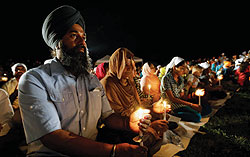|
Six weeks after a white supremacist gunned down Pardeep Kaleka’s father and five others at a Sikh temple in the US last year, Kaleka was skeptical when a former skinhead reached out and invited him to dinner.
But Kaleka accepted, and he’s grateful he did. Since then, the grieving son and repentant racist have formed an unlikely alliance, teaming up to preach a message of peace throughout Milwaukee, the largest city in Midwestern Wisconsin state. In fact, they’ve grown so close that they got matching tattoos on their palms—the numbers 8-5-12, the date the gunman opened fire at a Milwaukee-area Sikh temple before killing himself minutes later.
It wasn’t easy for Kaleka to meet Arno Michaelis, a 42-year-old who admits he contributed so heavily to the white-power movement that he might have helped influence the shooter. Kaleka knows Michaelis’ history—his lead singing in a white supremacist band, the white-power and swastika tattoos, the countless fights and more than a dozen arrests.
 |
| A makeshift memorial is seen before a candlelight vigil in the parking lot the Sikh Temple of Wisconsin |
|
 |
 |
| Pardeep Kaleka (left) and Arno Michaelis show off their matching tattoos |
People during a candlelight vigil in the parking lot of the Sikh Temple of Wisconsin on Monday, Aug. 5, 2013 |
But he also saw the good work Michaelis has done since he quit the racist movement in the mid-1990s. Kaleka, 37, wanted his father’s death to be a catalyst for peace, and he saw in Michaelis a partner whose story could reinforce the message that it’s possible to turn hate into love.
“We were both hoping ... we could take something tragic and turn it into something positive—a learning experience for the entire community,” Kaleka said. “We were both on that same mission, in our different ways.”
Michaelis had written a book called “My Life After Hate,” in which he describes how he lashed out at the world starting in kindergarten and how the birth of his daughter made him realize he needed to change. He also works with kids on community service projects.
Kaleka still has lingering fears that Michaelis might relapse and return to his old ways. But as he’s gotten to know Michaelis, he says the boulder of doubt has become a pebble.

Michaelis, an information technology consultant, understands the skepticism. He knows he hurt so many people during his seven years in the white-supremacy movement that his sincerity will always be questioned, which is why he works even harder to regain people’s trust.
The two men have teamed up to create Serve2Unite, a community group that works to counter violence with peace. Kaleka, Michaelis and others visit middle schools and high schools, where Kaleka describes how gunman Wade Michael Page walked into the Sikh Temple of Wisconsin last year and killed six people he didn’t know. Then Michaelis describes how the gunman’s white-supremacist background was nearly identical to his own.
Invariably, the children are riveted, Kaleka said. Afterward several will come up and ask how they can get involved.
Kaleka and Michaelis look nothing alike. Kaleka is a clean-cut Indian who teaches high school social studies. Michaelis, who’s white, has both arms covered in tattoos that mask earlier racist messages. But as they sat together in the temple recently, just down the hallway from the bedroom where Kaleka’s father was shot, they seemed like brothers, insulting each other good-naturedly and arguing over who was more handsome.
That brotherhood began at their first dinner. Sitting in his car outside the restaurant, Kaleka watched Michaelis walk inside and wondered if he was crazy to be meeting with a former skinhead. Still, he summoned the courage to do it.
Michaelis immediately asked about a bandage on Kaleka’s eye, the temporary remnant of a mishap Kaleka suffered while bathing his daughter.
“There was no, ‘Hi, how you doing?’ He went straight from seeing me to showing concern,” Kaleka said. After Kaleka told him what happened, Michaelis admitted that he too was a klutz, and a friendship was born.
Michaelis doesn’t shy away from discussing his past. He grew up in an alcoholic, emotionally cold household. He began to rebel as early as kindergarten, bullying other kids on the bus and picking fights on the playground. He eventually got into the white-power movement for the shock value, but the more he associated with haters, the more he began to hate.
But hating was exhausting. He couldn’t watch Green Bay Packers games because black and white players were playing together. He couldn’t watch TV because Hollywood was a Jewish conspiracy. He loved “Seinfeld” but he had to record it on a videotape labeled “Amber’s second birthday party” so his white-power friends wouldn’t know he thought a Jew was hilarious.
Eventually, the combination of his daughter’s birth and a friend dying in a street fight was the catalyst for him to move
on.
|